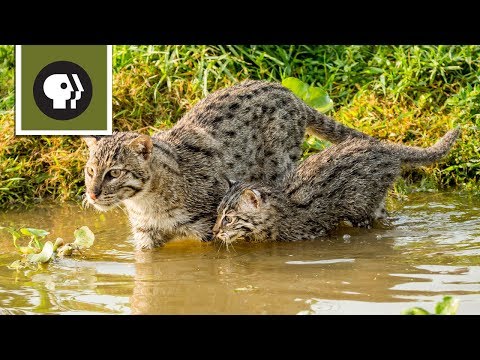
Fishing Blog & Store: Fishishere™
Understanding the Fishing Cat (Prionailurus viverrinus)
The Fishing Cat (Prionailurus viverrinus) is a truly unique wild feline that has managed to adapt its lifestyle and hunting techniques to wetland environments. It is predominantly found in South and Southeast Asia, in regions that are replete with marshes, swamps, reed beds, and mangroves.
Physical Characteristics of the Fishing Cat
Standing apart from its feline kin, the Fishing Cat has a robust build, medium size, and a distinctive coat pattern that is remarkably designed for its environment. The body length of an adult can range between 57 to 78 cm (22 to 30 in) excluding the tail which can add an additional 20 to 30 cm (7.9 to 11.8 in).
The Fishing Cat’s coat is a unique blend of olive-grey with dark spots arranged in stripes running along the length of the body. Its muscular build, comparatively shorter tail, and webbed paws contribute to its distinctive profile that aids in navigating wet habitats and swimming.
Habitat and Distribution: Where Do Fishing Cats Live?
Despite being known for their aquatic lifestyle, Fishing Cats are versatile and can thrive in a variety of habitats within their geographical range. This includes marshes, mangroves, reed beds, and swamps in South and Southeast Asia. Notably, they are found in countries such as Sri Lanka, Nepal, India, Bangladesh, Thailand, and Indonesia.
Diet and Hunting Techniques: How Do Fishing Cats Feed?
Fishing Cats have a diverse diet primarily consisting of fish, but they also prey on other creatures like frogs, crustaceans, and even birds and small mammals when the opportunity arises.
Remarkably, they have developed a hunting technique that takes full advantage of their aquatic environment. A Fishing Cat may lightly tap the surface of the water, mimicking insect movement to attract fish. When a fish comes within range, it strikes with its paw, capturing the prey.
Conservation Status and Threats: What Challenges Do Fishing Cats Face?
Fishing Cats are currently listed as Vulnerable on the IUCN Red List. The primary threats to their survival stem from habitat destruction, pollution, and human-wildlife conflict. Protection and conservation efforts are in place to help preserve these incredible creatures and their unique habitats.
Behaviour and Reproduction: Understanding the Life Cycle of the Fishing Cat
Like most felines, Fishing Cats are solitary animals. Females maintain territories that may overlap with others, but males tend to have separate territories. They communicate through scent marking, leaving their scent on various objects within their territory.
In terms of reproduction, the gestation period lasts between 63 to 70 days, after which a litter of 1 to 4 kittens is born. The kittens are nurtured by the mother until they are old enough to establish their territories.
In Conclusion: The Unparalleled Aquatic Feline
The Fishing Cat, with its distinct lifestyle and adaptations, represents an extraordinary facet of the world’s biodiversity. Understanding and preserving this remarkable species is paramount in the grand scheme of conserving our planet’s rich natural heritage.

Copyright: The Fascinating World of the Fishing Cat: A Deep Dive into an Extraordinary Species
https://fishishere.com/the-fascinating-world-of-the-fishing-cat-a-deep-dive-into-an-extraordinary-species
 CampingSurvivalistHuntingFishingExploringHikingPrivacy PolicyTerms And Conditions
CampingSurvivalistHuntingFishingExploringHikingPrivacy PolicyTerms And Conditions
